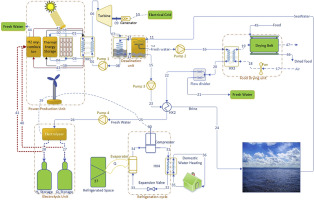International Journal of Hydrogen Energy ( IF 7.2 ) Pub Date : 2019-02-01 , DOI: 10.1016/j.ijhydene.2018.12.191 Muhammad Luqman , Yusuf Bicer , Tareq Al-Ansari

|
In this study, a solar and wind energy-based system integrated with H2O2 combustor is developed to produce fresh water from sea-water desalination, electricity, cooling, hydrogen, and oxygen as well as to provide food drying and domestic water heating. The main components of the proposed system contains concentrated solar power (CSP), wind turbine, Rankine cycle, multi stage flash (MSF) desalination unit, water electrolyzer, a refrigeration unit, a food drying system, oxy-hydrogen combustor, domestic water heater, as well as hydrogen and oxygen storage units. Furthermore, for continuous operation of the system during night time and in cloudy weather conditions, a thermal energy storage (TES) unit and oxy-hydrogen combustion unit are integrated to the system. Based on energy and exergy balances, performance assessment of the proposed system is conducted. Moreover, effects of various parameters such as solar irradiation, wind speed and ambient temperature on some of the outputs of the system are investigated. The results illustrate that the proposed system fulfills most of the remote community requirements in an efficient, environmentally benign and uninterrupted way. The obtained results for the reference case show that with installation of parabolic trough concentrators (PTCs) on an area of 111,728 m2, the plant produces net electrical power of approximately 11.4 MW, approximately 828 m3/day of freshwater, about 36 kg/s of hot air for food drying, about 31 kg/s of heated domestic water, approximately 920 kg/day of H2 and about 2.26 MW of cooling. The overall energy efficiency of the system is found to be 50%, while the exergy efficiency of the system is 34%. In addition, the energy and exergy efficiencies of single generation in which there is only electrical power output are approximately 15% and 16%, respectively.
中文翻译:

氢氧燃烧器支持的基于太阳能和风能的偏远地区可持续多联产系统的热力学分析
在这项研究中,基于太阳能和风能的系统与H 2 O 2集成在一起燃烧室的开发目的是利用海水淡化,电力,冷却,氢气和氧气生产淡水,并提供食品干燥和生活用水加热。拟议系统的主要组件包括集中式太阳能(CSP),风力涡轮机,朗肯循环,多级闪蒸(MSF)脱盐装置,电解水机,制冷装置,食品干燥系统,氢氧燃烧器,家用热水器以及氢气和氧气存储单元。此外,为了使系统在夜间和多云天气条件下连续运行,将热能存储(TES)单元和氢氧燃烧单元集成到系统中。基于能量和火用平衡,对所提出的系统进行性能评估。而且,各种参数的影响,例如太阳辐射,研究了系统某些输出的风速和环境温度。结果表明,所提出的系统以有效,环境友好和不间断的方式满足了大多数远程社区的要求。获得的参考案例结果表明,在111,728 m的区域上安装了抛物线形槽式集中器(PTC)如图2所示,该工厂产生的净电能约为11.4 MW,淡水约为828 m 3 /天,用于食品干燥的热空气约为36 kg / s,加热后的生活用水约31 kg / s,约920 kg /天。 H 2和约2.26 MW的冷却。发现该系统的总能量效率为50%,而该系统的火用效率为34%。此外,仅产生电力输出的单代发电的能量效率和火用效率分别约为15%和16%。


























 京公网安备 11010802027423号
京公网安备 11010802027423号